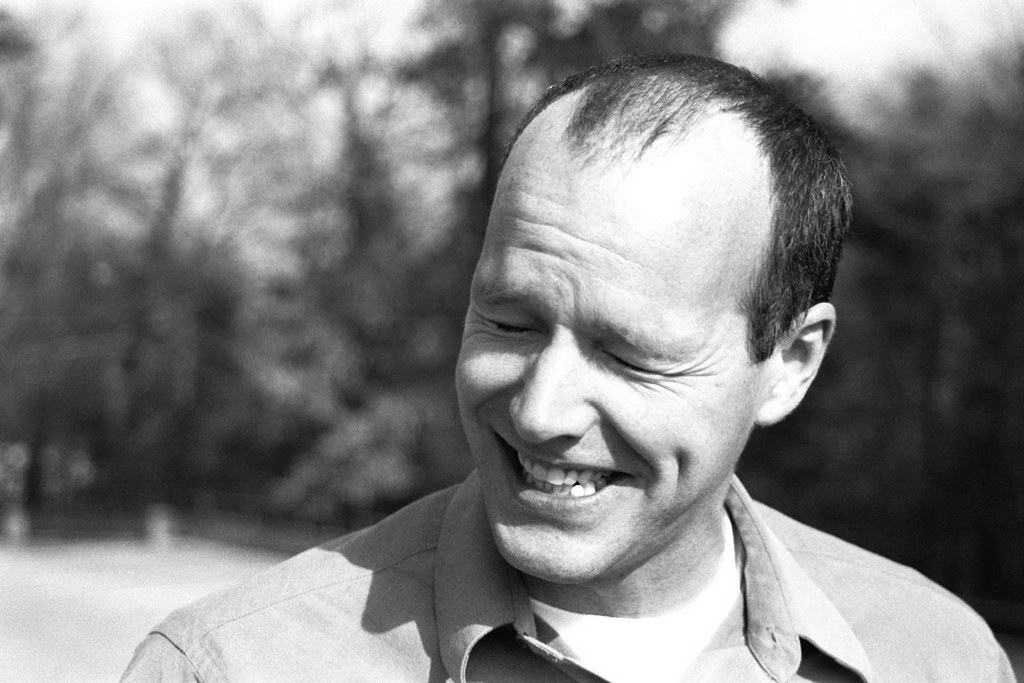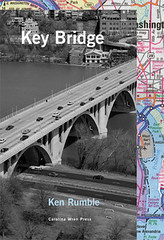Season Three Draws to a Close
Well, that's it folks -- Season Three of the Desert City is over; the long summer break becons; grant applications await writing; foundations await calling; poets await invitations -- it's that happy time when informal house readings, Lucipo meetings, and the traveling show all bud up like so many red bud blossoms down here in NC.
And what a way to go out -- Carl Martin and Lee Ann Brown were a super combination; both of them talented readers as well as writers, deft in their relations with the audience.
Carl opened the evening with several poems from his first book Go Your Stations, Girl including one about spying an odd couple making toys through the window of an unusual house. He went on to read several pieces from Genii Over Salzberg, including one of my favorites "X2.1." He closed with new work from an unpublished manuscript titled Rogue Hemlocks.
Lee Ann began her reading with a long piece, a pastiche of quotes from a film maker that she spent a day on a train with. The piece ranged over a wide territory, compelling in scope and frequently quite funny. Next she read from a series of haiku written about and during her several trips to her country of birth, Japan. From there, she dipped into her first collection, Polyverse, reading several pieces that were either produced with or to last week's DC visitor, Lisa Jarnot. She closed singing several of her ballads; one of which, "Three Rings," sung at the request of Evie Shockley.
We wrapped up the evening at Acme restaurant in Carrboro with a boisterous crowd, champagne toasts, and much talk of things to come.
Thanks to everyone for making this one of the most exhilirating series of readings I've ever been a part of. Thanks to all the poets who came to read from near and far; thanks to the audience for supporting the series so thoroughly and consistently; thanks to Internationalist Books for hosting us; thanks to Todd & Laura (again) for giving us a place to relax post readings, and thanks to Kathryn for making the production of the series an easy task by remembering everything I forgot.
Much love to all involved -- stay tuned for news of next season and check out Marcus Slease's review of Saturday's reading.
Below are the intros I wrote for Lee Ann and Carl:
(they appear in reverse order because I wrote LA's before CM's)
Lee Ann Brown & Carl Martin Intro
1. Announcements
a. First Annual Carrboro Book Fair, May 7th, at the Carrboro Arts Center
b. Second Annual Carrboro Poetry Festival, May 21 – 22, Carrboro Century Center
c. Desert City returns in September of 2005; some of the likely readers include: Claudia Rankine, Ron Silliman, Brenda Coultas, K. Silem Mohammad, Rosmarie Waldrop, and Brent Cunningham
2. Welcome
a. Thanks for coming
b. introduce yourself
a. The Desert City is a non-profit, volunteer run and funded organization. Both of the poets tonight are appearing without receiving any compensation. Please make a donation to support the poets and the series. Please buy books to support the internationalist.
b. Sign up sheet in the back for announcements of future events
2. Thank yous
a. Internationalist
b. Lee Ann & Carl
c. all of you
d. Kathryn
3. Tonight, though, we are here to see Lee Ann Brown & Carl Martin.
4. As the preeminent literary critic Ken Rumble once wrote of Lee Ann Brown, her poems combine “adroit ability with an expansive range of styles.” And I was right. Or as Brown writes herself, “It’s about really listening to /// When I listen to myself // I hear the world” and later, as if a skipping record, “The single solitary singer // is not -- // is not tuned into // one frequency only.” And thus it is in these poems that the speakers, and there are many, see the possible inside every impossible.
5. Lee Ann Brown is a poet, film maker, and publisher and received her early training in these trades here in North Carolina. Raised in fair, windy Charlotte, Lee Ann has returned recently for a residency in Asheville. Her first collection of poems, Polyverse, was selected as part of the New American Poetry Series in 1999; her second book, The Sleep that Changed Everything, was published in 2003 by Wesleyan University Press. Lee Ann also holds what some might call an honor: she was the very first poet presented in the Desert City Poetry Series.
6. “Desire is the ground / from which we act,” she writes in “Desire Device” and that theme, desire, coupled with a belief in the incantatory power of words fills Brown’s poems with transformations: “I didn’t know how / this little / song would / end / the last stanza not right / until last night / when / to change the form / to Leonine / everything / like the form / is changed / a long long line / like your sweet kisses / which liquefy / my limbs / & get better & better / impossibly / real.”
7. Play – playing with words, ideas, forms – is the method of these transformations – she writes, “way past way -- / Outer space – Meditation’s intensities // Convert play’s determining eye -- / To sight.” And later, “She said I had a ‘language problem’ / but I am just trying to let gorgeous risk in.” And again, “set down your paying work & / tongue & groove / me again.”
8. The aim of all this play is to mix and join, to create communication in the sense of communion with people and the world – she writes in “Sustain Petal”: “Come on, you who remembers your dreams / who acts upon them in this world / come you who I often and silently call / so that I may be with you / Come and sustain me / and I will sustain you / with what sustenance I have / with the curls of revolutionary quiet / with lovely baroque convolutions of thought / … / Make a new life / for those around us fully / and for those / to come // to come / To.”
9. Please welcome Lee Ann Brown.
10. In “The Vision” the opening poem of Carl Martin’s most recent collection, he writes: “The shrill, militaristic scream / of a bird / over the Baltic sea / is as dented, gray / as a warboat’s hull, its white wind / … / Watchfires at sea are an illusion, / a desert’s swill mirage / spilling into the sailor’s eye. / … / Rain seeds the water with red. / A corpse like a scarecrow rises in the sky” and thus begins a gothic journey, terrible and wonderful, through myth, history, and love. “Love terrifies when you need / one who hates, despises her love. / A cobra is poised / in the cave of Tristan and Iseult / where cherub-fresh cheeks / and liars tip the chalice.”
11. Like Lee Ann Brown, Carl Martin was raised in North Carolina, Winston-Salem specifically where he still lives. It is there where I met Carl several years ago in March when he appeared in the Desert City for the first time. Martin set out to become a painter during his time at Maharishi International University, but upon discovering the poetry of the great John Ashbery, he instead pursued poetry, creating a poetic style with roots in the baroque and expressionism. For this innovative style, Martin has received high praise from poets as diverse as Ashbery himself and formalist John Hollander.
12. The lush and surreal world that Martin describes is haunted. He writes in “Salvation’s Wraith,”: “Betrothed to silk, white lace / the long wands of the trees / bend, annoy, as they await / the promenade of bees, / … / She’ll not starve us at the well / whose maiden spirit’s wrist, / hand extended towards us, / flows with milk.” And later, “Harmonious sister with red hair, thick limbs / that sink into a death, / I Can’t imitate your teetering dance, / or sanely will your image away! / Your sinuous ballet sweeps through these halls.”
13. This velvet world is the product of a vision that recognizes that the eye is an active participant in creation. He writes in “Jupiter Flower”: “I fly like hawk or oriole over fields / of hay, the Jupiter flower / glistening soft and blue. One eye piercing sunlight, / the other stuck in the clouds.” And, “In the poet’s mind, birds click / like castanets, around the wrists / of a dancing gypsy.” And in “The Day in Graz” he writes: “The song of the trees rustles toward me: / a chameleon’s key / in the rusted lock // that whistles in the air / like wind, / and reveals a glimmering hand / bent like the neck of a swan.”
14. Through all these beautiful scenes, fearful and awed, the narrator – like Dante’s Virgil – guides us as if, as he writes in “Conversation”, with “someone whispering to us in the dark / room with the tiger spotted lily.”
15. Please welcome Carl Martin.



1 Comments:
A fabulous year, Mr. Ken. You make things happen and we all love you for it. Onward!
5/2/05, 7:43 PM
Post a Comment
<< Home